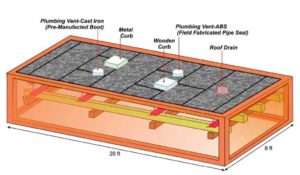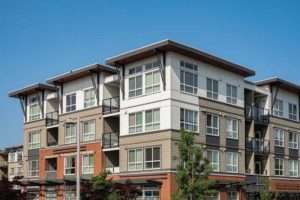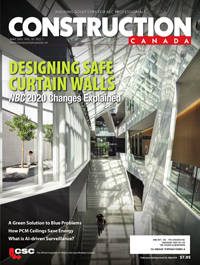Using roofing parapets for airtight roofs

Condensation of this proportion can often be mistaken for roof membrane leaks. This condensation can affect not only the roof, but also the walls and cladding systems; especially those cladding systems susceptible to freeze-thaw action of water, such as masonry and other cementitious materials.
Special attention to the detailing of the air barrier should be made during the roofing process. As roofing is often the first membrane system put in place, it is important to include it for the supply and installation of a robust and transition material that will allow for both, the connection of the air and vapour barrier of the roof assembly to the main roofing membrane and the wall air barrier system. This approach will help avoid difficult to detail situations that may result in air barrier leakage.
Codes, standards and a little something extra
Currently in Canada, the following references to codes and standards help address air barriers and roofing assemblies for the design and construction of buildings:
- National Building Code of Canada (NBC)
○Provincial Building Codes
○Part 9: Small Buildings
○Part 5: Environmental Separation
- CAN/ULC-S741-08(R2020), Standard for air barrier materials—Specification
- CAN/ULC-S742:2020, Standard for air barrier assemblies—Specification
- ASTM E2178-21a, Standard Test Method for Determining Air Leakage Rate and Calculation
of Air Permeance of Building Materials - ASTM E2357-18, Standard Test Method for Determining Air Leakage of Air Barrier Assemblies
- ASTM E3158-18, Standard Test Method for Measuring the Air Leakage Rate of a Large or Multizone Building
- CSA A123.21:14 (R2019), Standard Test Method for the Dynamic Wind Uplift Resistance of Membrane-roofing Systems

There are also some interesting documents prepared by the NRC that outline the results of air leakage testing on various types of low slope roofs. Refer to the following documents:
- “Mechanically attached single single-ply and polymer modified bitumen roof membrane assemblies”
- “Air movement impacts on roofing systems [air] part 2—Impact of air intrusion on moisture performance of mechanically attached roofing systems”
A key takeaway from these documents is the key to successful air leakage performance in roofing is in part the attention to detailing of the membrane at seams, penetrations, and perimeter terminations. It is noteworthy to mention, they do not look at performance differences between wind uplift testing with a self-adhered air and vapour barrier as part of the assembly and that without. There is evidence in a manufacturer’s listings of their tested systems that those systems tested with an air and vapour barrier at the structure level do perform better than those without.
Test your knowledge! Take our quiz on this article.
Notes
1 Refer to the National Research Council of Canada (NRC) at nrc.canada.ca/en/research-development/products-services/software-applications/wind-uplift-resistance-calculator.
Paul Johannesson is the technical development manager—Canada for Siplast Inc. He is a graduate of the University of Toronto, building science program, as well as the architectural design technology program at Humber College. He is registered with the Ontario Association of Certified Engineering Technicians and Technologists (OACETT) as a certified engineering technologist (C.E.T.), and with the Building Science Specialist Board of Canada as a building science specialist (BSS). Johannesson’s career covers more than 30 years of experience within the architectural, engineering, building material manufacturing, and distribution communities. Johannesson has been an adjunct professor at Humber College, where he taught in the architectural design technology and construction project management programs between 2002 and 2012. He is also a past president 08/09 of the Ontario Building Envelope Council (OBEC), where he was on the board of directors from 2004 until 2010. Johannesson currently sits on the board of directors for both OBEC and IIBEC SOC.



